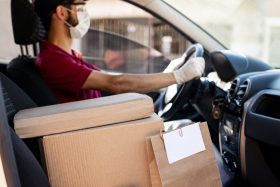Driving on the Job: What Teens Can & Can’t Do

For many newly licensed drivers, having a car can mean more options when it comes to employment. Without having to rely on other people for rides or public transportation or having to ride a bike or walk, it can be a lot easier for them to get to and from work. Or perhaps they’re hoping that being able to drive will allow them to do more types of work. But if you’re hoping that driving will be a key part of your job, it’s important to know there are a lot of rules in place about what teens can and can’t do with regards to driving for work.
Laws for Teens & Driving on the Job
Under requirements from the U.S. Department of Labor, employees who are 16-years-old and younger are strictly prohibited from driving on public roads as part of their job. Even if they have a valid driver’s license, employers aren’t allowed to require them to be driving on public roads. If a teen employee is 17 years old, they may be able to drive as part of their jobs, but under the following limited circumstances:
- Driving occurs only during daylight hours
- The employee holds a valid driver’s license for the type of driving involved in the job performed. (Example: a teen who only has a standard driver’s license cannot be doing any driving that requires a commercial driver’s license or a chauffeur’s license.)
- The employee has successfully completed a state-approved driver’s education course and has no history of moving violations at the time of being hired
- The car/truck being driven by the teen has seat belts installed for the driver and passengers in the vehicle and the employer has informed the employee that seat belts must be used while the vehicle is being driven.
- The vehicle being driven does not have a gross vehicle weight of 6,000 pounds or higher
- Driving is only considered an incidental or occasional part of the job, meaning the teen employee does not spend more than one-third of their time in the workday or more than 20% of their work time in a workweek driving.
If a 17-year-old meets the above requirements to drive, there are further restrictions about what types of driving they can do. The DOL prohibits 17-year-old employees from doing the following:
- Towing vehicles
- Handling route deliveries or route sales
- Transportation for hire of property, goods, or passengers
- Making time sensitive deliveries, such as food deliveries
- Transporting more than three passengers, including other employees of the employer
- Driving beyond a 30-mile radius of the place of employment
- Making more than two trips away from the primary place of employment in any single day to deliver the employer’s goods to a customer
- Making more than two trips away from the primary place of employment in any single day to transport passengers other than employees of the employer
Given all these legal restrictions, you’ll need to be at least 18 years old before driving can be a considerable part of your job. Even if you’re considering earning extra money by delivering for a service like Doordash, GrubHub, or Uber Eats and you’re under the age of 18, you’ll be out of luck. Each company has their own age requirements for drivers who deliver for them, but none of them allow drivers to be under the age of 18.
Safety Tips for Teen Food Delivery Drivers
For 18 and 19-year-olds who are able to drive as part of their job, it can be exciting to have new options for employment. But at the same time, there are also safety considerations to keep in mind.
Road safety basics like obeying the speed limit, wearing a seat belt, and driving without distractions are all crucial parts of staying safe on the job. But delivering pizzas can be a surprisingly dangerous occupation. Not only is there the risk of getting into a car accident, robbery is another very common occupational hazard for food delivery drivers since they often work alone, carry cash with them, and may be working late at night.
When delivering food, be sure to park in well-lit areas and stick to walking in highly visible areas, avoiding places like side or back doors or walking through dark alleys. If possible, position your car so that the headlights of your car illuminate the front of the house you’re looking for. If the address you are supposed to be delivering to seems suspicious for some reason, such as if the house has no lights on or appears to be vacant, move to a safe location, stay in the car, and call your manager for further directions about how to handle the situation. When you leave your car, make sure it is locked and turned off, taking the keys with you.
Some other good safety tips to keep in mind while delivering food is to carry as little cash as possible and avoid showing cash while handling transactions. Your employer may have limits on how much cash delivery drivers can carry. Also, be sure to figure out exactly where you’re going before you leave the store. Stopping to ask for directions or figure out where you are can leave you vulnerable to criminals.
Get Help from a Michigan Lawyer
Teen employees have the same rights as everyone else when it comes to workplace safety. If a teen is injured on the job, it’s important to have a lawyer on their side who can make sure all of their rights are being protected and hold the right people accountable. At Goodwin & Scieszka, you’ll be able to talk to a car accident lawyer, but we also specialize in handling workplace accident lawsuits. Contact us today to get started.
Image: iStock / Julio Ricco






